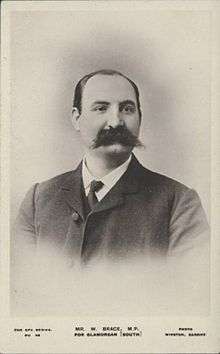South Glamorganshire was a parliamentary constituency in Glamorganshire, Wales. It returned one Member of Parliament (MP) to the House of Commons of the Parliament of the United Kingdom, elected by the first past the post system.
Overview
The constituency was created by the Redistribution of Seats Act 1885 for the 1885 general election. Of all the Glamorgan seats created by the 1885 redistribution, South Glamorgan was the only one where the Liberal Party could not be assured of victory. The Bute and Dunraven families exercised a powerful influence. The mining areas in the north of the constituency, including the lower reaches of the Rhondda, and the cosmopolitan town of Barry were strongly Liberal but these were juxtaposed against the conservatism of the Vale of Glamorgan and the genteel settlements of Penarth and Llandaff.
The constituency was abolished for the 1918 general election.
Boundaries
Created in the redistribution of seats in 1885 from the old Glamorganshire constituency which had been in existence since 1541, the seat covered a wide area that included Bridgend, Porthcawl, Coity, Ewenny, Ogmore, Llanharry, Llanharan, Cowbridge, Llantwit Major, Dinas Powis, Pendoylan, Bonvilston, Barry, Penarth, Llantrisant, Tonyrefail, Pontyclun and Beddau, and areas which are now part of Cardiff (including St Fagans, Radyr, Whitchurch, Llanishen and Lisvane). It was scrapped in the next redistribution of seats that took place in 1918.
Members of Parliament
History
Major Wyndham-Quin
From 1885 until 1895 the seat was held by the Liberals but in 1895 it was captured by a Conservative landowner, who held the seat with a reduced majority in 1900.
William Brace
In 1903, South Glamorgan became the focus of an internal battle within the Liberal Party around whether a labour representative should become the candidate. Although the miners composed only a fifth of the electorate, the claims of William Brace, vice president of the South Wales Miners Federation were also championed by the dockworkers of Barry. Following the intervention of the Liberal Chief Whip, Brace was duly chosen and won the seat in 1906. He held it until its abolition in 1918.
Elections
Elections in the 1880s
Elections in the 1890s
Elections in the 1900s

William Brace
- official Liberal candidate
Elections in the 1910s
General Election 1914/15:
Another General Election was required to take place before the end of 1915. The political parties had been making preparations for an election to take place and by the July 1914, the following candidates had been selected;
See also
References
- 1 2 3 4 5 6 The Liberal Year Book, 1907
- ↑ The Constitutional Year Book, 1904
- 1 2 Debrett's House of Commons & Judicial Bench, 1901
- 1 2 The Times House of Commons Guide 1910, 1911, 1919, Poltico's Publishing Page 101 1911 Section
- ↑ The Times House of Commons Guide 1910, 1911, 1919, Poltico's Publishing Page 92 1910 Section
- 1 2 Debrett's House of Commons & Judicial Bench, 1916
- ↑ The Times House of Commons Guide 1910, 1911, 1919, Politico's Publishing Page 92 1910 Section
- 1 2 Although some sources described Brace as a Liberal or Lib-Lab candidate, the lengthy discussion in Roy Gregory, The Miners and British Politics shows that he stood as a Labour Party candidate in both 1910 elections, and was surprised not to face a Liberal Party opponent in December.
- ↑ Western Mail 5 Sep 1914
Sources
Books and Journals
